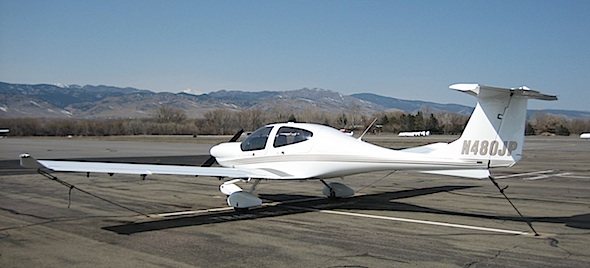Airport handled 50,000 flights last year
Eric Karnes | Mar 8, 2010

Boulder has an airport – but how many of us have a clue what goes on there? Let’s take a little look. Ironically, our curiousity may have been aroused by the fiery collision that killed three in the skies at Boulder’s northern periphery Feb. 6.
Aside from that, for many of us, it’s just that place out east with planes coming and going, especially on weekends, and very involved in launching and receiving the many glider hobbyists. Most of us have seen its runway lights glowing prettily at night.
As luck would have it, the City recently released its annual report on operations at Boulder Municipal Airport during 2009. Let’s start with some of the basics.
The airport, located north of Valmont Rd. and east of 47th Street, was established in 1928 and is one of the oldest public airfields in Colorado. The landing strip, used initially by a manufacturer of small bi-planes, was called Hayden Field before being acquired by the City of Boulder.
A City of Boulder “enterprise”
Boulder Municipal Airport, which bears the Federal Aviation Administration designation “BDU,” is used mainly by business and personal aircraft. About 150 planes are based at the field, of which nearly a third are sailplanes. BDU operates as a City of Boulder “enterprise,” meaning that no general revenue funds are used to support airport operations. Other than federal and state funds used for airport improvements, BDU is self-sufficient. The airport derives revenues from fuel sales, building rentals and hangar and ramp tie-down fees.
During 2009 over 50,000 landings and take-offs occurred at BDU. About 86 percent of the field’s operations are by locally-based aircraft. The remaining 14 percent are “transients,” or aircraft based elsewhere stopping in for fuel or conducting business or personal visits in the community. Even in the face of recession operations at BDU have not declined, and increased slightly from the number of flights in 2007 and 2008.
Several years ago, the City hired Tim Head, a former U. S. Air Force officer, as manager of BDU. Head has supervised improvements to the airport, including runway and parking ramp repaving and renovations to hangars and the terminal building. Among many in Boulder’s aviation community BDU had been a forgotten asset, allowed by previous City administrations to languish until Head’s appointment.
“Airport Days” drew 3,000
Head has also worked to involve the airport in the Boulder community. Annual “Airport Days” have been held, with the latest, in June of last year, drawing about 3,000 visitors. The airport is also home to the University of Colorado Flying Club and a base for the Boulder Composite Squadron of the Civil Air Patrol, the civilian auxiliary of the U. S. Air Force that conducts search and rescue missions for lost persons and missing airplanes.
About 80 people are employed by companies with operations a BDU, the largest of which is Air Comm, a manufacturer of parts for helicopters. Other companies at BDU are Journeys Aviation, Specialty Flight Training, Brungard Aviation and Vanaero Aircraft Services.
Journeys Aviation is BDU’s designated fixed-base operator, functioning under contract with the City to provide fuel, services, tie-down and hangar space to tenants and visiting aircraft. Journeys Aviation also operates the Boulder terminal building and a flight training school.
Other tenants at BDU include a soaring school and several soaring clubs, with operations on the north side of the field along Independence Rd. Colorado Sky Sports, a skydiving company, also operates from BDU.
More renovations coming
In 2010 the City of Boulder plans to do more renovations and repairs at the airport, including to the main east-west runway and to airport utility systems. Another Airport Day is scheduled for Saturday, June 19, 2010.
A controversial issue about BDU has been noise from arriving and departing aircraft. Since 2006 the airport has operated under noise abatement procedures that attempt to alleviate some of the problems. Between 2006 and 2009, the number of annual noise complaints declined from over 200 to 45. Most of the complaints came from six nearby households.
Because of the airport’s proximity to Hayden Lake on the west and a hillside on the east, there are no plans to extend the runway to attract larger aircraft. The main intent of the airport’s master plan is to upgrade facilities and services for the benefit of locally-based aircraft and those visiting the community.
Additional information about Boulder Municipal Airport, as well as the 2009 annual report, can be found in a section www.bouldercolorado.gov/airport of the City of Boulder website. Airport manager Tim Head can be reached at (303) 441-3108

